The Basenji—also known as the Congo Dog—is traditionally known as a hunting dog, watchdog, and sighthound that originated in Africa. It is also known as a barkless dog because it makes unique yodeling sounds!
Even though the Basenji dog breed does not pop up very often, there is a lot to be said about this beautiful pup that may come in many different gorgeous colors.
For instance, did you know that this dog is one of the oldest breed groups to be recognized by the American Kennel Club (the AKC)? Or that Egyptian artifacts oftentimes contained images of Basenjis, oftentimes being given to pharaohs as a prized gift?
This small dog with its high energy levels also happens to be really good at lure coursing.
You are probably already looking at a variety of great Basenji breeders out there for your special companion and are thinking about the different colors that this amazing pup can come in—and trust us when we say that there is a lot to be said in the color department!
This pup, which is not only known for its elegant speed, curled tails, and beautiful coats, is also noted for its beautiful colors that can make your breath stop.
Read more to find out everything you need to know about Basenji colors out there!
What Are The Colors Of The Basenji?
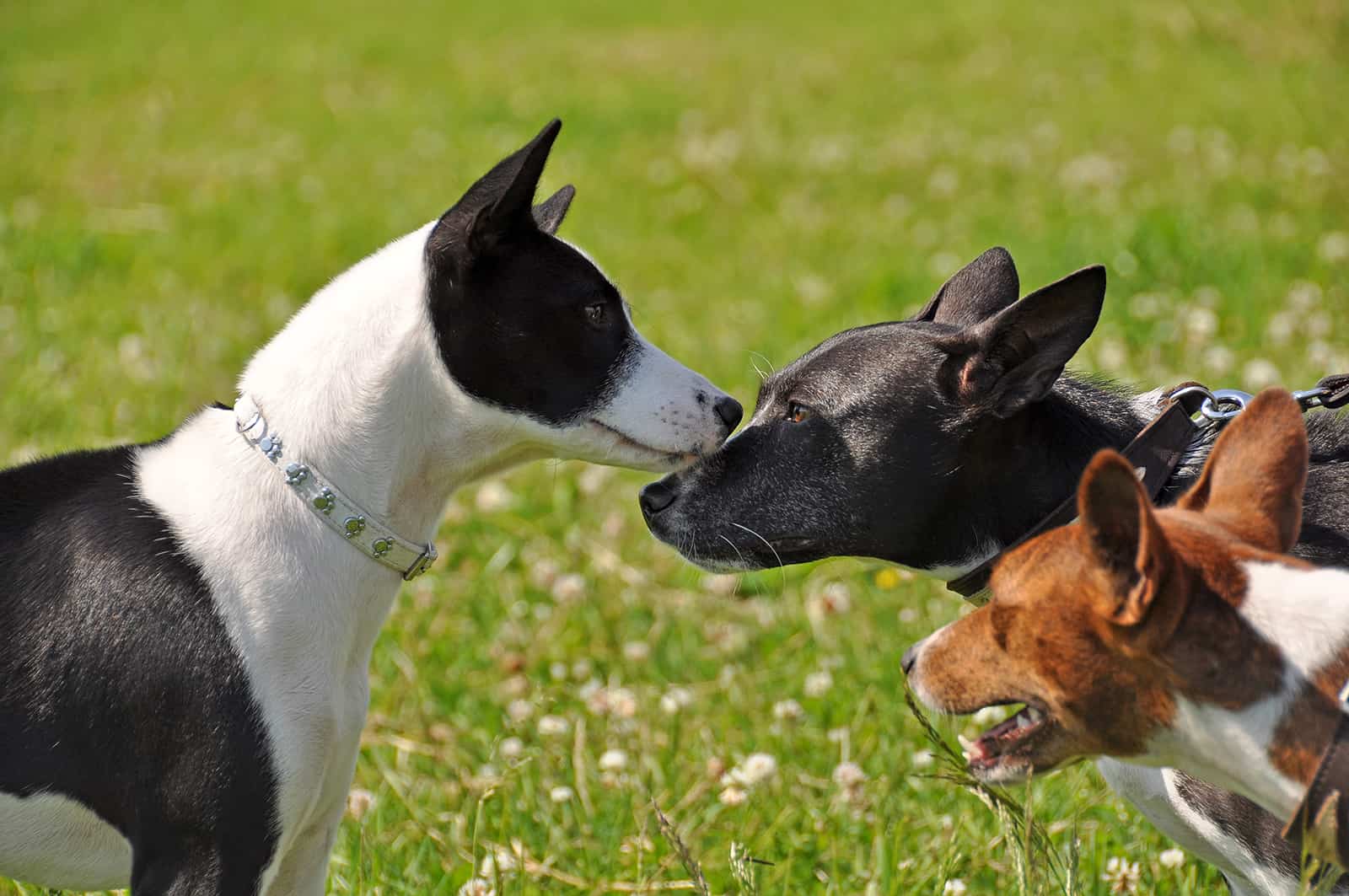
This beautiful dog which is mostly kept for breeding and show ring purposes generally comes in colors such as black and white, red and white, brindle and white, and tricolor.
There are also many other colors out there such as cream and white or the blue tricolor—but these can be found more often in areas such as Africa as opposed to the US, where they are still considered quite rare.
When it comes to color, descriptions can be a bit complex, which is why we are here to help guide you through the myriad of Basenji colors.
According to the AKC breed standard, the standard Basenji’s smooth coat can come in colors of red and white, black and white, black tan and white, and brindle and white. The breed can also have brindle markings.
But this dog’s other various colors and markings can be registered as legitimate—they just might get a penalty for color if they are presented in the show ring with other colors, depending on the judge that is examining them.
Other Things To Note About Standard Colors
The Basenji standard has it that the white color must cover the areas of the chest, feet, and tip of the tail.
The breed might have white legs, white feet, or a white collar around the throat as well as white on the face—all of this is allowable, but not a requirement for accepting the dog as a standard Basenji.
However, the color of the coat should not completely be white.
The colors as well as the markings found on the Basenji’s coat must be rich and well-defined.
There is a clear-cut distinction between all the colors found on a standard Basenji’s coat—you must always, for instance, be able to separate the red from the white.
If the Basenji has a coat with tricolors, all of the patterns must have distinct lines where the colors are separate from one another.
The demarcation must be visible and vivid—unlike the one’s found in a sable coat, where the color gives a more dusty appearance to the dog.
Some Basenji mixes may inherit the same colors as purebred Basenjis, but these mixes are not recognized by the AKC.
Red And White
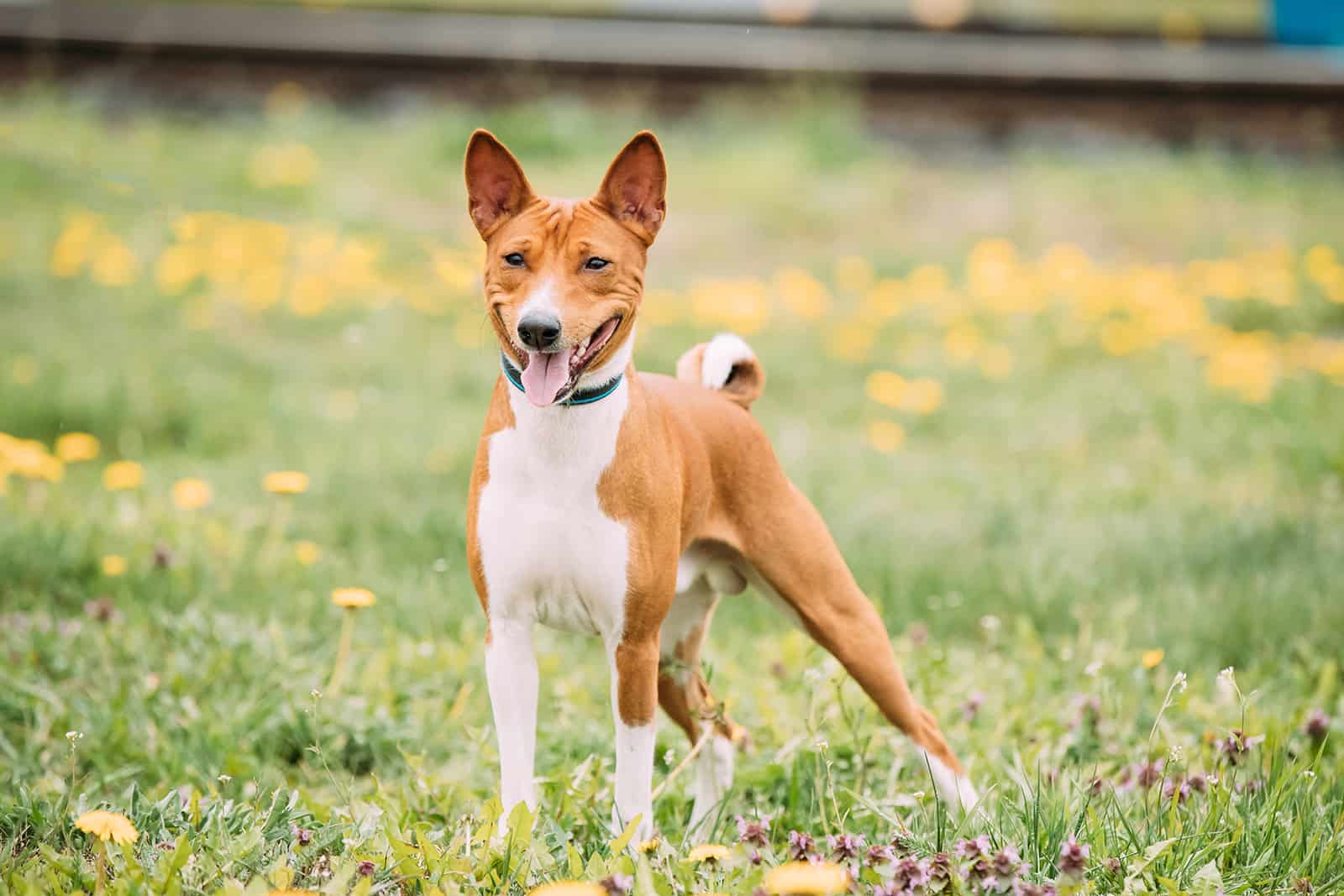
This is the first color combination that people usually think of when they hear the name “Basenji.”
The red found in a red and white Basenji can be compared to the red color found in a Rhodesian Ridgeback or even to a Pomeranian’s colors.
The truth of the matter is that this color combination is quite flexible—many different shades of red are possible, and none of them are considered “gold” when it comes to standard.
You may find a dog that has the color of chestnut red—which is highly saturated, rich, and beautiful, but you may also find a Basenji that has a red which is more like a tan, orange, or a beige.
However, the important thing to note that even though the hue of the red is flexible when it comes to breed standards, the color red should remain quite distinct from the white. In other words, the red should not bleed into the white.
Additionally, you should not find any random white hairs straying into the beautiful smooth white coat. The white should be completely uncontaminated; in other words, it should be like a pearl.
Your best bet if you are looking for a red and white Basenji is to find two pure-for-red dogs that will produce puppies that are the same.
Pure-for-red dogs do not have any additional color genes apart from red, which will ensure that the puppies will also be the same.
Black And White
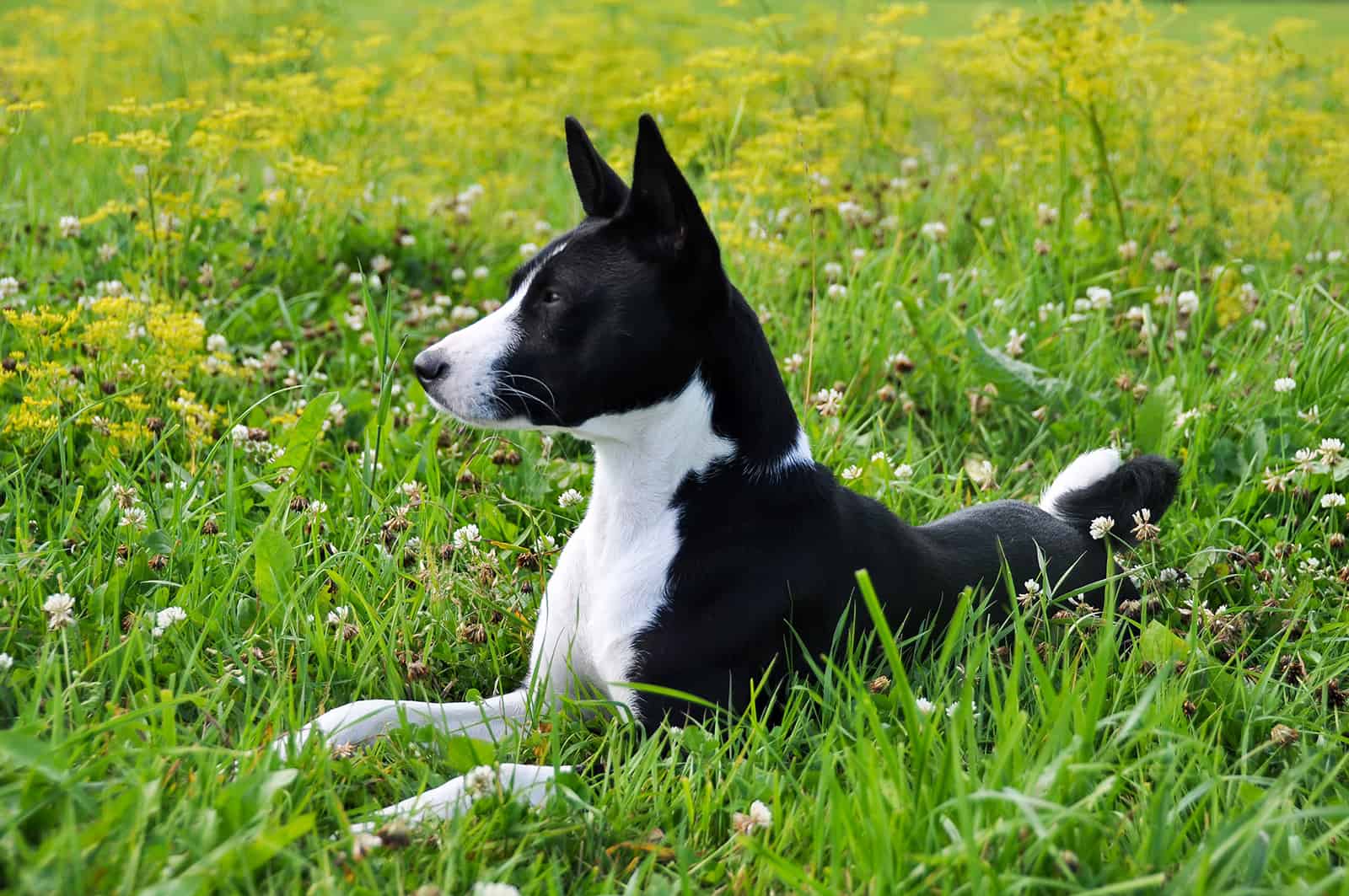
Like your Cavalier King Charles Spaniel’s colors of black and white, the traditional Basenji can come in this gorgeous color combination as well.
The black in this beautiful combination must be the shade of a pitch-dark, pure black with a glossy sheen to it.
Like the red and white combination described above, this combination also must have vivid distinctions between the colors.
If you are on the lookout for a black and white Basenji puppy, you should know that black is pretty much a dominant color, which means that if one of the pup parents is black, a litter of black and white puppies is probably.
If both of the parents are black and white, then all of the puppies will inevitably end up being black and white—however, depending on the genetic code that was passed onto them, they might carry the recessive gene of another color.
Most black and white Basenjis are actually known to carry a recessive color gene that cannot be expressed because of the dominant gene of black.
Because they are heterozygous, the next generation of puppies might inherit the recessive gene and even have it expressed if the second dog parent carries the same gene.
Brindle And White
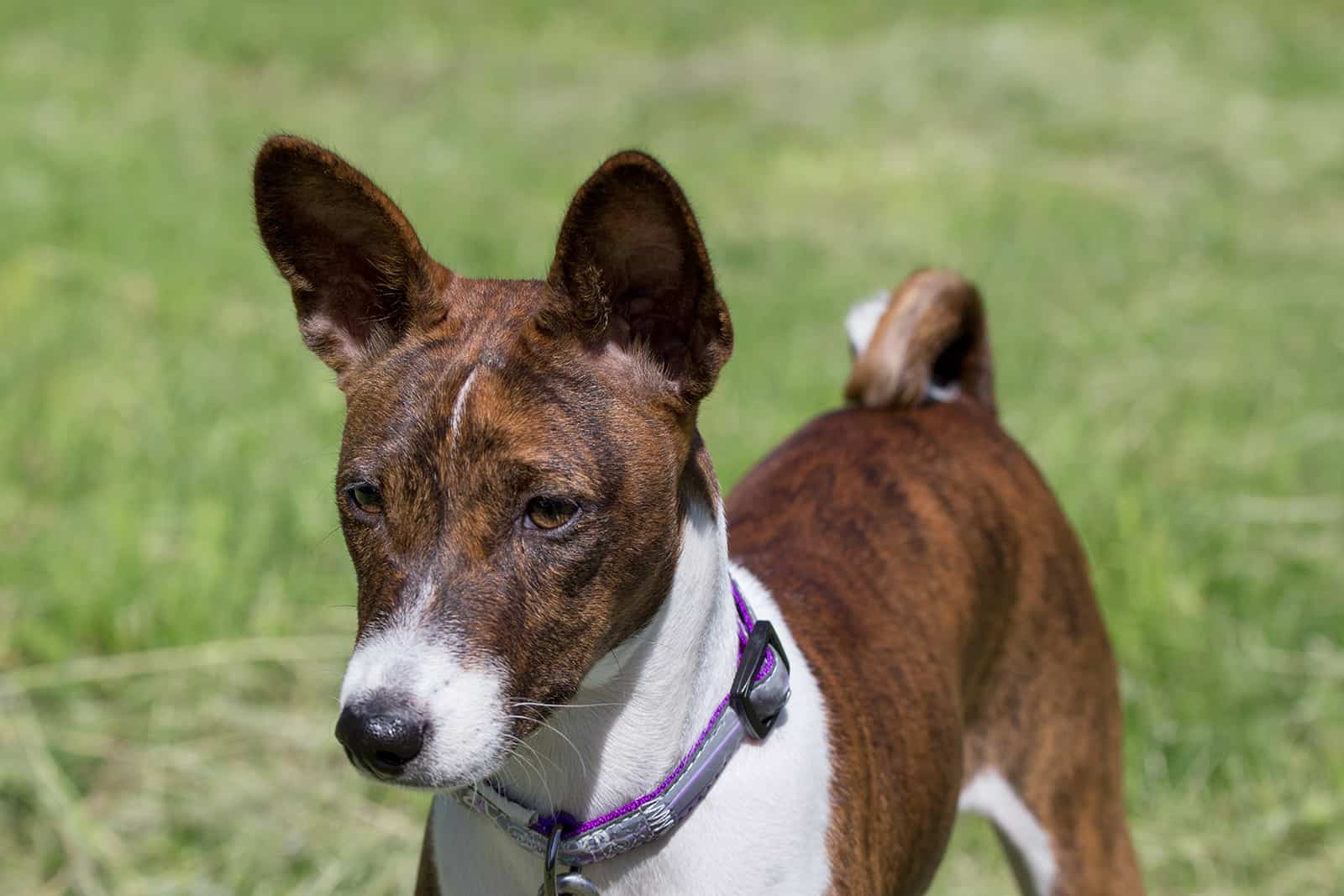
A Boxer’s coat colors might contain brindle markings, but the Basenji’s brindle and white is its own unique set of beauty. An interesting thing about this color combination is that they were only bred in the 1980’s after a unique importation project.
The Basenjis that have the color combination of brindle and white are like the red and white—however, what distinguishes them is that the former has black stripes in the background of the color chestnut red discussed above.
If you are in the lookout for a brindle and white Basenji puppy, you will find that its parents will be two brindles or perhaps a brindle parent with a tricolor parent. Both sets of parents might produce red and white puppies or brindle and white puppies.
Black, Tan, And White (Tri-Color)
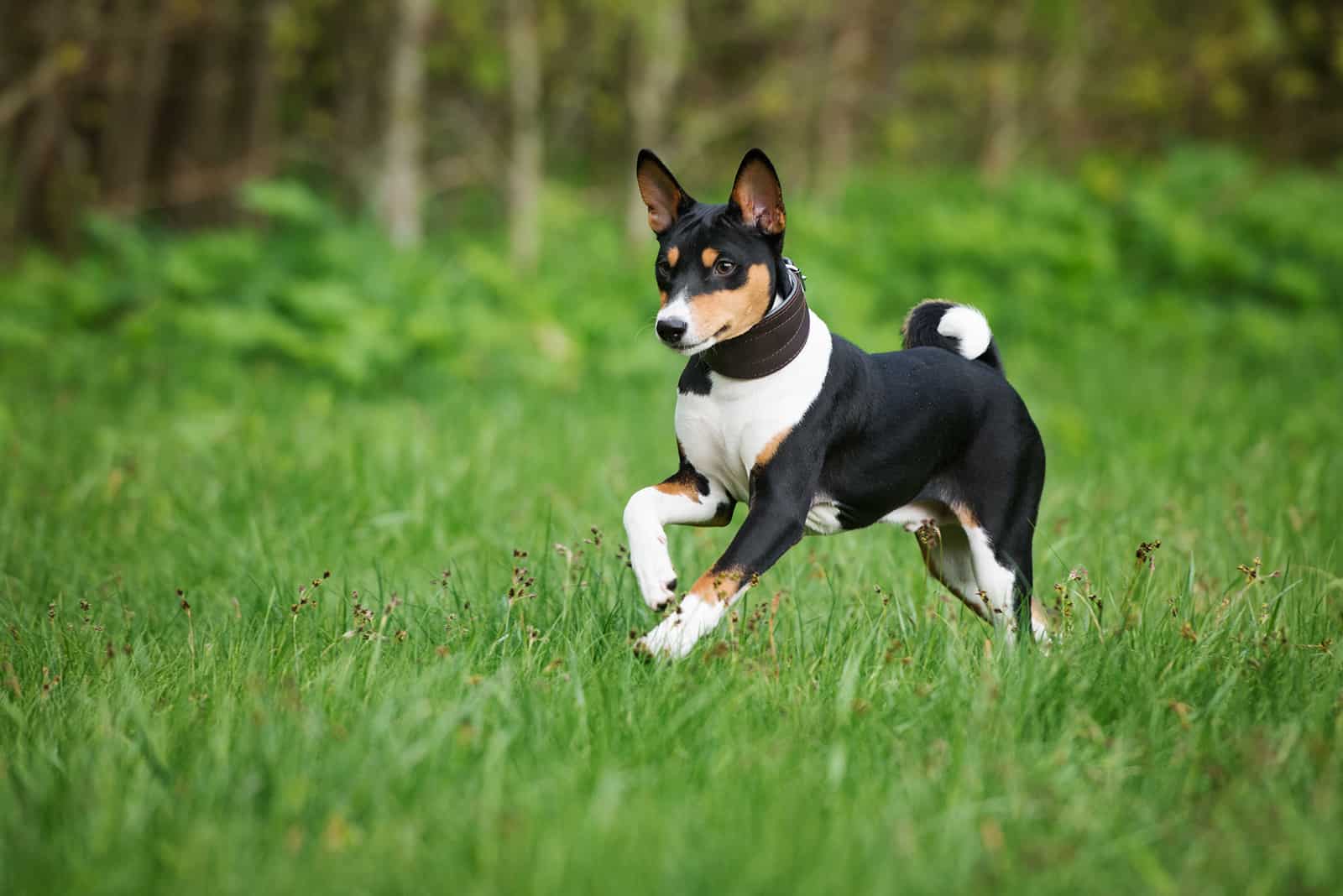
One color combination of the precious Dalmation is black, white, and tan, so this tricolor Basenji is not alone out there! These Basenjis are oftentimes called “tris” by Basenji fans.
This is a beautiful color combination that looks absolutely stunning on a Basenji.
As expected, the base color of this tricolor coat is white, and the rest of the colors can be found in areas such as the ears, upper legs, eyebrows, and cheek.
If you are on the lookout for a black, tan, and white Basenji, you might find one in a litter in which there are two tri-colored Basenjis.
However, you might find one in a litter of two tri-factored dogs (which just means that they carry the gene for tri-coloration which is not expressed).
More About Tricolor Basenjis
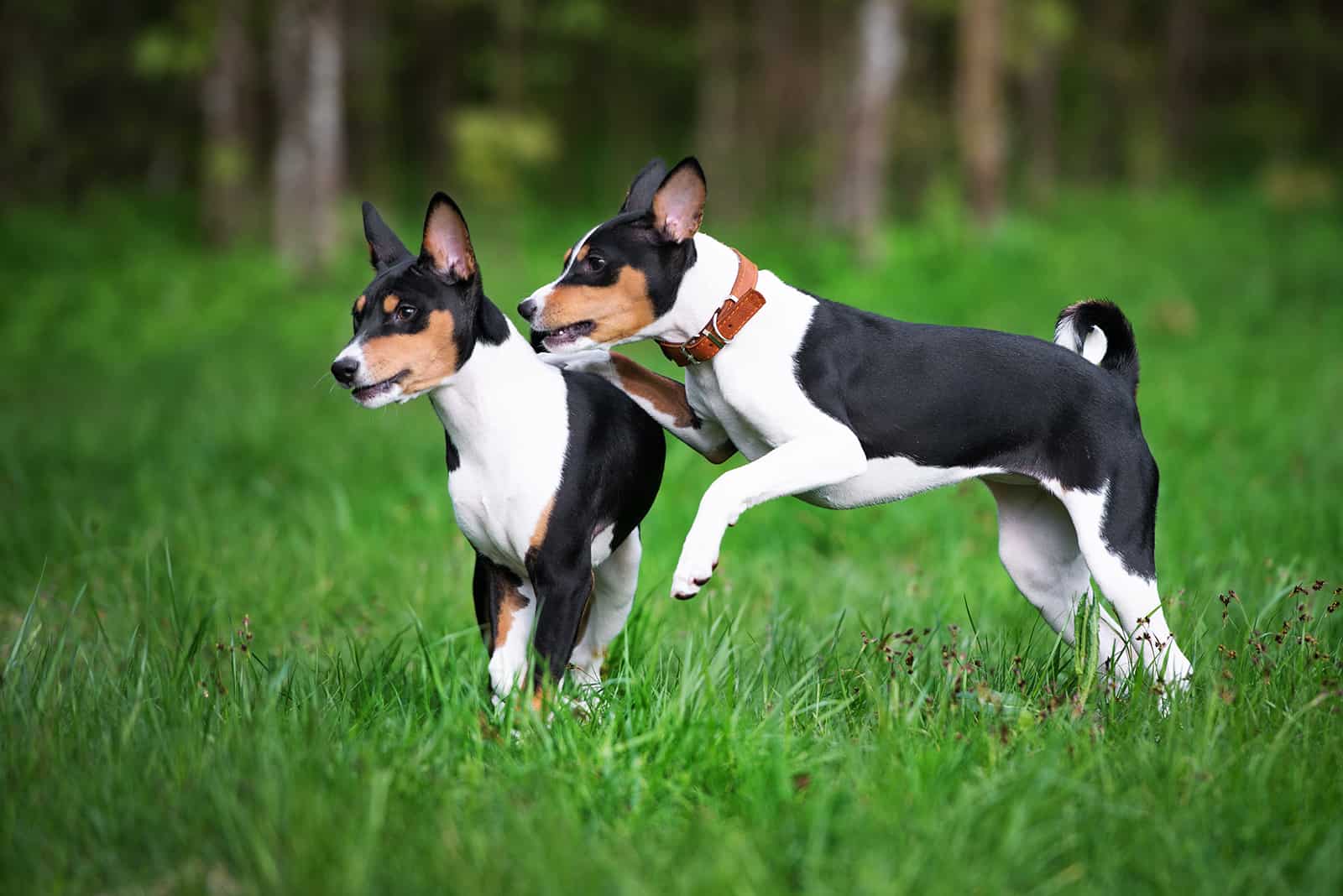
You can expect tricolor Basenjis to occasionally have a bar across the cheek, which is still acceptable according to standard descriptions of Basenji. The shape of the bar as well as the hue may vary—they might be richer or fainter depending on the pup.
These tris are usually referred to as barred tris. If a barred tri is bred with a pup, and they both carry the tri gene, a puppy that has the recessive genes of black and white might be born.
These puppies might have strand tan hairs in the black portions of their coats—this is more undesirable than a puppy born with a pure black coat section.
If a tricolor pup has brindle markings within the red area of its coat, the AKC would deem this pup appropriate for dog showing. Additionally, Basenji lovers have a special name for this color combination: trindle.
The brindle color may be found in all the expected places. Some might believe that brindle may only be found in certain areas such as the cheeks of the trindle, but this is far from the truth.
An expected tricolor that has red on its black overcoat is similar to the brindle tricolor with a black overcoat.
The black overcoat that you find in these color combinations is separate from the colors of brindle and red. They are genetically inherited and passed on to the descendant puppies independent of the other color.
You will find that certain breeders are not big fans of the trindle Basenji. However, if a trindle is bred with all of the appropriate traits, they may easily win best in show.
More About The Color White
Like we have mentioned before, the necessary white markings must be found on the feet, chest, and tail tips, whereas the other areas of a standard Basenji’s body might or might now have white.
When it comes to the degree and intensity of the white, this is something that breeders cannot agree about.
Some consider a Basenji’s white too pearly, too dull, or too flashy. There is not an agreed upon statement about the intensity of the whiteness among breeders.
You might also find puppies that have only a speck of white on its toes, but breeders generally prefer that the entire foot of the puppies are bred to be white.
Other Colors
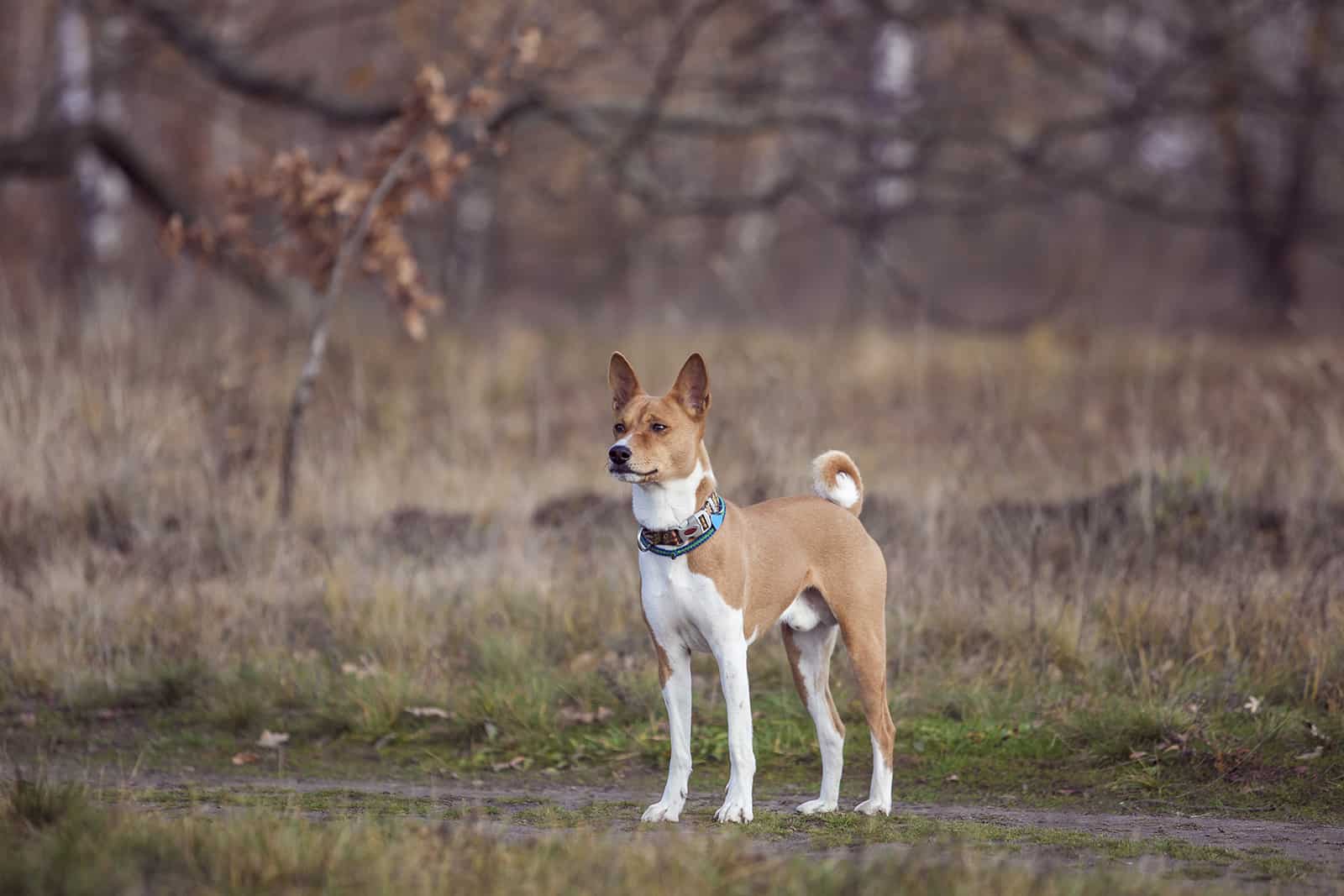
You have learned about the standard colors of the Basenji, but did you know that Basenjis might come in other rarer colors? These are accepted colors, but they are so unique that they can hardly be found in the U. S.
The interesting thing is that the Basenjis in Africa are commonly found to have these other colors, even though they are rare in the U.S. Today they are being imported so that the genes of Basenjis within the U.S. can gain more variety.
The interesting this is that the AKC is actually more flexible when it comes to accepting the following alternative colors we will discuss below when compared to the Basenji Club of America, which typically lists the standard colors.
However, breeders that follow both clubs would love to see other colors becoming more accepted.
Cream And White
The Havanese’s colors are known to contain quite a bit of cream, but they are not the only ones!
Certain Basenjis may come in cream where you would find the usual red might be found. The cream we are talking about here has a light or pale yellowish hue.
It is important to note that in the beginning when breeders first started breeding Basenjis, this color combination was pretty common—even more common than the popular red that we find today.
However, breeders wanted to eliminate the color cream and the green eyes that came with it; needless to say, they were almost victorious.
Because breeders were determined to eliminate this color, they are rare even in Africa, where this coat color originated.
You can still find this color combination, though. Some breeders are trying to make this color combination more popular once again!
What is the difference between a black Basenji and a blue Basenji?
There are certain Basenjis that fall under the category of cream and white Basenjis that have a certain blue (diluted black) hue with cream highlights on their coats.
Sometimes people have these two colors confused for that reason, but blue is just a lighter hue than black.
These tricolors were once more common in the days when the cream and white Basenjis thrived, but they too began disappearing when breeders set out to eliminate the cream and white Basenjis.
Mahogany And White
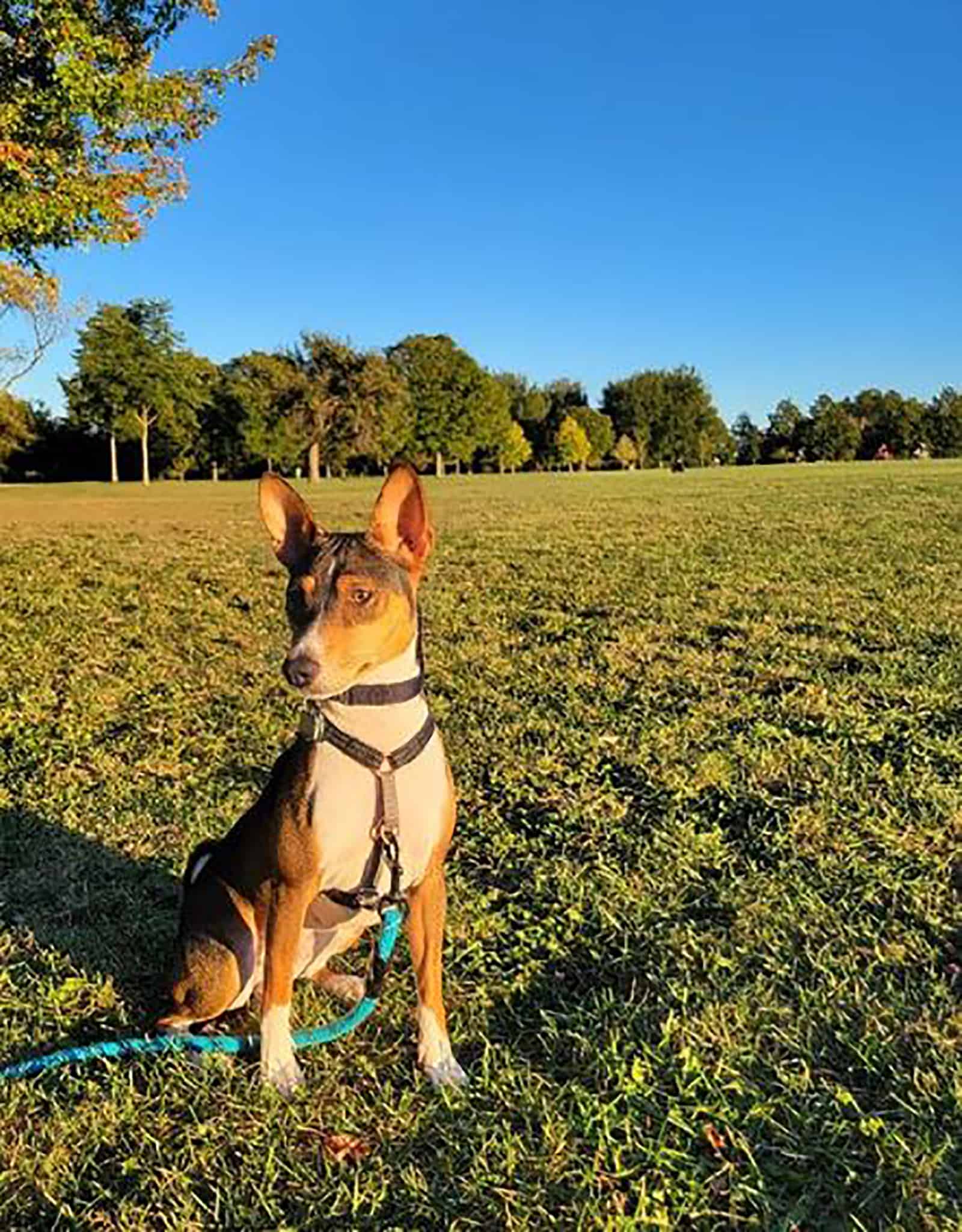
Photo from: @leo.the.basenji
The mahogany and white Basenji is very rare. In fact it is so rare that it is next to impossible to find a picture of one that exists out there.
The mahogany in this color combination is like red, but it is much darker in color because of the black concentrated in the red portions of the coat.
Sable And White
The Shiba Inu colors of sesame (similar to sable) can be compared to the sable and white Besanji, if you are not sure about how this color combination would look like.
These Basenjis would have the typical red and white color combination—however, you will find black on the tips of the red hairs, giving the pup a dusty, exotic look.
Trindle
We have discussed this combination a bit above.
This combination is a tricolored dog that has brindle in its coat. They have brindle markings in their coat instead of the more commonly found chestnut markings.
They also have these markings on their muzzle and ears, making this combination quite special.
Basenji Markings
We have already mentioned that the AKC accepts brindle markings as part of the breed standard, but did you know that certain markings such as capped markings, a black mask on the face, or a black saddle over the rib cage are also allowed?
Even though they are acceptable markings, they are rare since they are not as commonly seen as other markings.
The Basenji Coat
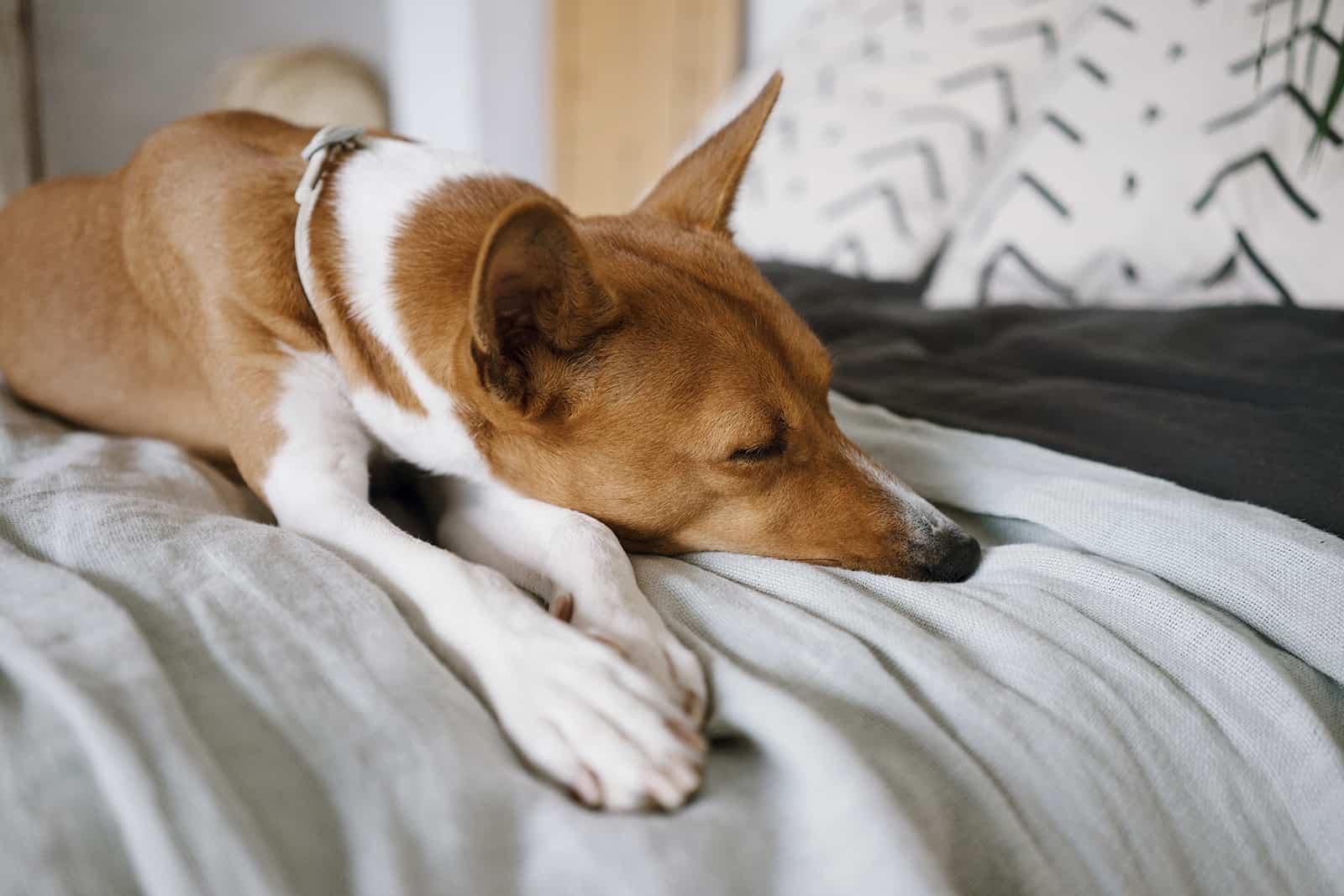
In addition to the colors you might find in a purebred Basenji, you also may be wondering about the standard looking coat.
The skin of the standard Basenji can be best described as pliant, whereas its short coat can be described as fine.
Their short coat was developed due to the Basenji needing protection from the humidity and heat of their country of origin.
Since they are a hunting breed, it helped that their coat was short so that it would not snag plants and other natural material as they were running to catch prey.
The skin was developed to be pliant because it helped with the dog’s lifespan. Since this is a hunting dog, it did not help if its skin was easily ruptured, causing infections that could easily become major health issues in the long run.
The skin of a typical Basenji also creates the facial wrinkles you might see on the dog as well as protecting them. The pliant skin produces the Basenji’s typical facial wrinkles as well as safeguarding them as they work.
You will also find that the Basenji might develop an undercoat because of cooler weather. This coat does not have the sheen of typical Basenji coats, which is considered normal.
Do Different Colors Cost More Than Others?
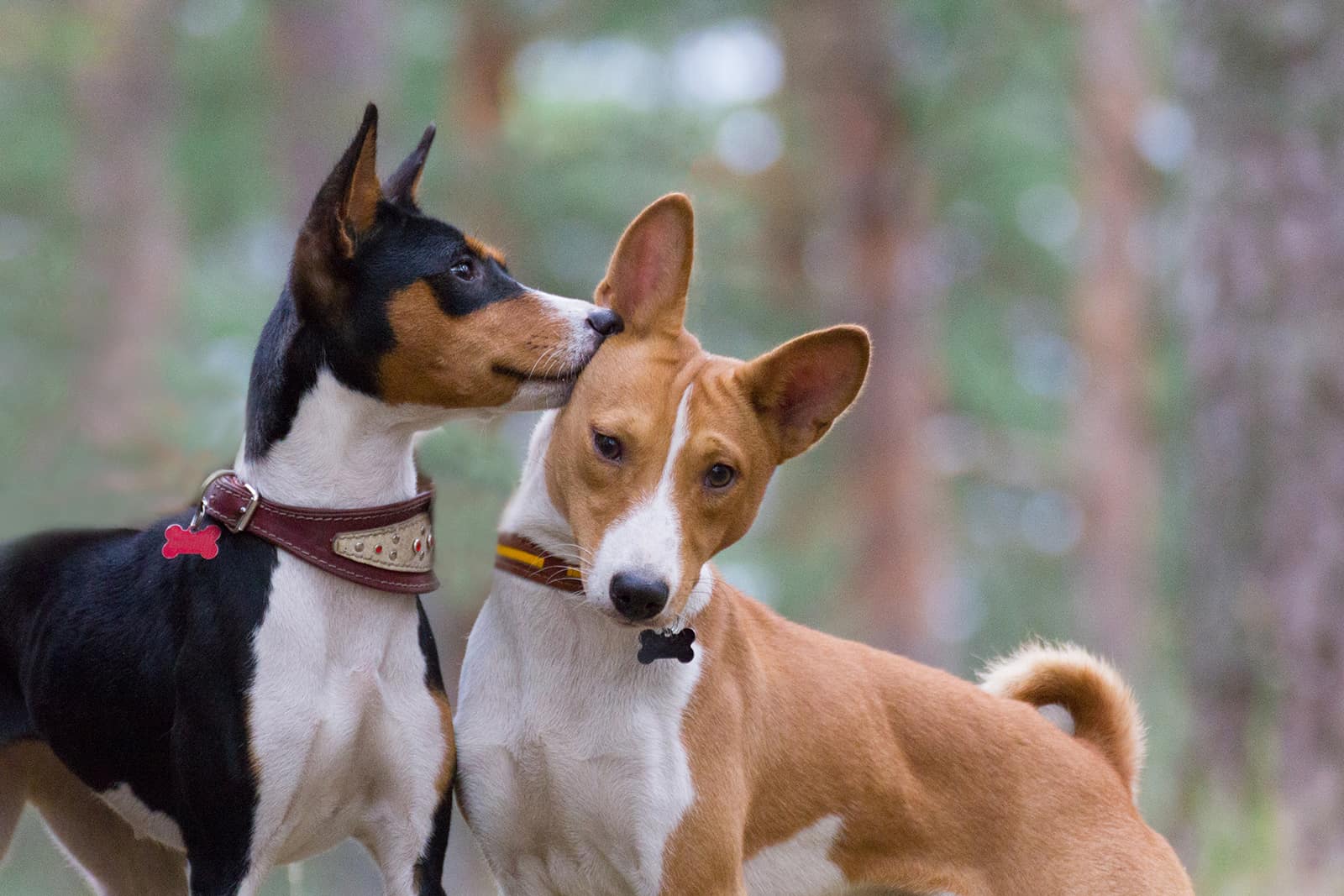
Disqualifications for color do not exist among Basenji breeders, which is why they are more interested in breeding pups for factors such as breed standard conformation, personality traits, and health.
You might find certain breeders which will charge more for certain pups, such as those with brindle markings, than your typical red and white Basenji. However, this is usually not the case.
The truth of the matter is that breeders will spend an equal amount of money breeding pups of a rarer color and those displaying typical colors.
However, most people might pay more for a rarer color because they are not aware of this fact, even though most breeders are.
This usually is not a problem because, as we have noted above, rarer colors are not as common because they have been eliminated by breeders throughout the years within the U.S.
You still should not be shocked if you find extremely rare colors coming at higher prices—these colors are more costly to breed, so the selling point would be higher than standard colors.
Which Basenji Color Should You Get?
The truth is that all Basenjis are fantastic dogs that have the potential to be your best friend, regardless of color.
You should never buy a dog solely based on color because there are so many other factors, such as health and personality, which should be deciding points.
For instance, you should try to find a pup that perhaps has been bred by parents that don’t have health issues such as hip dysplasia, Fanconi syndrome, or progressive retinal atrophy.
You should also strive to find a pup that has had excellent socialization and dog training, because these things will immediately affect your family and lifestyle.
For this all, we recommend that you buy your Basenji puppy from only the most reputable breeder. That way you can be certain you are getting the highest-quality puppy out there.
Thinking about what dog food to purchase for your excellent pooch might be a more important question than color, but we still understand that with so many different coat colors, owners could probably have it all, and that’s okay too.
Just make sure that color is not your only factor when choosing a pup!
Conclusion: Basenji Colors
We hope that you have learned everything there is to know about this amazing pup’s colors, which are plentiful!
There are certain colors such as red and white and black and white which are much more common than cream and white or sable and white, which are rarer due to the breed’s history.
We have also mentioned the beautiful tricolored Basenji, which can come in all sorts of colors and markings that can make your breath stop!
When it comes to markings, brindle markings are usually what one typically thinks of in relation to these amazing dogs, but there are many other acceptable markings that you can find out there.
Typically, the Basenji’s colors are distinct from one another, which is an important marker of the breed which is important to remember.
Good luck with finding the Basenji colors of your choice! Who knows, maybe your beautiful pup wins a prize for its wonderful colors in the next dog show!
Read Next:
• 19 Fascinating Staffordshire Bull Terrier Colors
• Basenji Growth Chart – How Big Is The Smallest Hound?















